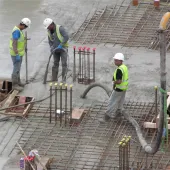HSE issues warning over new starter safety
HSE urges concrete and construction firms to tighten safety for new workers
The Health and Safety Executive (HSE) has renewed its call for employers to improve health and safety practices for new and temporary workers, warning that workers are as likely to suffer a workplace accident in their first six months as they are during the rest of their careers.
The warning comes as the concrete construction sector continues to face high turnover and an influx of early-career workers, particularly in roles such as formwork, precast production, ready-mix delivery, and site-based concrete placement.
The HSE says this elevated risk is often due to:
- Lack of experience in construction settings
- Unfamiliarity with equipment or layout
- Hesitation to raise safety concerns
- Pressure to impress or “get stuck in”
Workers new to concrete sites may not fully understand site-specific hazards such as live pours, trip zones near rebar, or moving plant in tight pour zones, the regulator warned.
Six steps to protect new and temporary site workers
The HSE has issued a practical six-step guide to help employers reduce risk:
- Assess capability
Evaluate physical ability, relevant experience, health, and language skills. - Deliver a proper induction
Include site layout, key hazards, and clear signage. Use plain language and visual aids. - Check and update control measures
Ensure PPE, barriers, and protocols are fit for purpose and understood. - Provide relevant information
Cover specific risks, such as working near formwork or with fast-setting concrete mixes. - Ensure active supervision
Make sure new starters know who to report to and are regularly checked in on. - Confirm understanding
Don’t assume compliance — ask questions and observe behaviour to ensure safe practice.
Gig economy and agency workers also highlighted
The HSE’s latest advice also covers gig economy, agency, and temporary construction workers — many of whom may arrive on site without full induction or clarity about responsibilities.
The guidance outlines the legal obligations of both labour suppliers and end-user businesses, with additional resources tailored for migrant workers, young people, and those in non-permanent roles.
With ongoing recruitment across the sector, particularly for summer infrastructure projects and public works, this guidance offers a timely reminder for contractors and subcontractors to review how they support new starters — not just in documentation, but in on-the-ground supervision and mentorship.
More information and resources available at: www.hse.gov.uk







